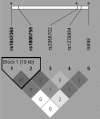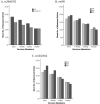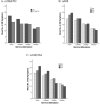Interactions Between Alcohol Metabolism Genes and Religious Involvement in Association With Maximum Drinks and Alcohol Dependence Symptoms
- PMID: 27172571
- PMCID: PMC4869897
- DOI: 10.15288/jsad.2016.77.393
Interactions Between Alcohol Metabolism Genes and Religious Involvement in Association With Maximum Drinks and Alcohol Dependence Symptoms
Abstract
Objective: Variations in the genes encoding alcohol dehydrogenase (ADH) enzymes are associated with both alcohol consumption and dependence in multiple populations. Additionally, some environmental factors have been recognized as modifiers of these relationships. This study examined the modifying effect of religious involvement on relationships between ADH gene variants and alcohol consumption-related phenotypes.
Method: Subjects were African American, European American, and Hispanic American adults with lifetime exposure to alcohol (N = 7,716; 53% female) from the Collaborative Study on the Genetics of Alcoholism. Genetic markers included ADH1Brs1229984, ADH1B-rs2066702, ADH1C-rs698, ADH4-rs1042364, and ADH4-rs1800759. Phenotypes were maximum drinks consumed in a 24-hour period and total number of alcohol dependence symptoms according to the Diagnostic and Statistical Manual of Mental Disorders, Fourth Edition. Religious involvement was defined by self-reported religious services attendance.
Results: Both religious involvement and ADH1B-rs1229984 were negatively associated with the number of maximum drinks consumed and the number of lifetime alcohol dependence symptoms endorsed. The interactions of religious involvement with ADH1B-rs2066702, ADH1C-rs698, and ADH4-rs1042364 were significantly associated with maximum drinks and alcohol dependence symptoms. Risk variants had weaker associations with maximum drinks and alcohol dependence symptoms as a function of increasing religious involvement.
Conclusions: This study provided initial evidence of a modifying effect for religious involvement on relationships between ADH variants and maximum drinks and alcohol dependence symptoms.
Figures



Similar articles
-
Genetic contributors to variation in alcohol consumption vary by race/ethnicity in a large multi-ethnic genome-wide association study.Mol Psychiatry. 2017 Sep;22(9):1359-1367. doi: 10.1038/mp.2017.101. Epub 2017 May 9. Mol Psychiatry. 2017. PMID: 28485404 Free PMC article.
-
Associations of ADH and ALDH2 gene variation with self report alcohol reactions, consumption and dependence: an integrated analysis.Hum Mol Genet. 2009 Feb 1;18(3):580-93. doi: 10.1093/hmg/ddn372. Epub 2008 Nov 7. Hum Mol Genet. 2009. PMID: 18996923 Free PMC article.
-
ADH1B is associated with alcohol dependence and alcohol consumption in populations of European and African ancestry.Mol Psychiatry. 2012 Apr;17(4):445-50. doi: 10.1038/mp.2011.124. Epub 2011 Oct 4. Mol Psychiatry. 2012. PMID: 21968928 Free PMC article.
-
Biology, Genetics, and Environment: Underlying Factors Influencing Alcohol Metabolism.Alcohol Res. 2016;38(1):59-68. Alcohol Res. 2016. PMID: 27163368 Free PMC article. Review.
-
Genetics of Alcoholism.Curr Psychiatry Rep. 2019 Mar 9;21(4):26. doi: 10.1007/s11920-019-1008-1. Curr Psychiatry Rep. 2019. PMID: 30852706 Review.
Cited by
-
ALDH2*2 and peer drinking in East Asian college students.Am J Drug Alcohol Abuse. 2017 Nov;43(6):678-685. doi: 10.1080/00952990.2017.1314489. Epub 2017 May 4. Am J Drug Alcohol Abuse. 2017. PMID: 28471244 Free PMC article.
-
Review: Environmental influences on alcohol use: Informing research on the joint effects of genes and the environment in diverse U.S. populations.Am J Addict. 2017 Aug;26(5):446-460. doi: 10.1111/ajad.12478. Epub 2017 Jan 24. Am J Addict. 2017. PMID: 28117924 Free PMC article. Review.
-
Quantile-Specific Heritability of Intakes of Alcohol but not Other Macronutrients.Behav Genet. 2020 Sep;50(5):332-345. doi: 10.1007/s10519-020-10005-z. Epub 2020 Jul 13. Behav Genet. 2020. PMID: 32661760 Free PMC article.
-
Intersection of familial risk and environmental social control on high-risk drinking and alcohol dependence in a US national sample of adults.Addict Behav. 2021 Feb;113:106668. doi: 10.1016/j.addbeh.2020.106668. Epub 2020 Sep 29. Addict Behav. 2021. PMID: 33045642 Free PMC article.
References
-
- American Psychiatric Association. Diagnostic and statistical manual of mental disorders. 3rd ed., rev. Washington, DC: Author; 1987.
-
- American Psychiatric Association. Diagnostic and statistical manual of mental disorders. 4th ed. Washington, DC: Author; 1994.
-
- Barrett J. C., Fry B., Maller J., Daly M. J. Haploview: Analysis and visualization of LD and haplotype maps. Bioinformatics. 2005;21:263–265. doi:10.1093/bioinformatics/bth457. - PubMed
-
- Beaver K. M., Gibson C. L., Jennings W. G., Ward J. T. A gene X environment interaction between DRD2 and religiosity in the prediction of adolescent delinquent involvement in a sample of males. Biodemography and Social Biology. 2009;55:71–81. doi:10.1080/19485560903054689. - PubMed
MeSH terms
Substances
Grants and funding
LinkOut - more resources
Full Text Sources
Other Literature Sources
Medical

